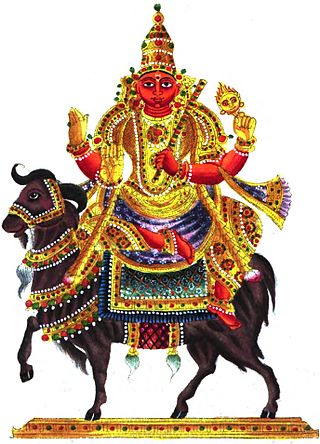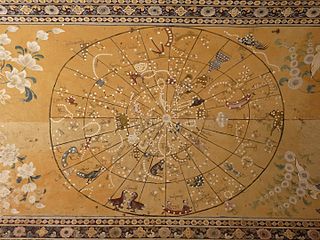Related Research Articles

Chandra, also known as Soma, is the Hindu god of the Moon, and is associated with the night, plants and vegetation. He is one of the Navagraha and Dikpala.
Hindu astrology, also called Indian astrology, Jyotisha and, more recently, Vedic astrology, is the traditional Hindu system of astrology. It is one of the six auxiliary disciplines in Hinduism that is connected with the study of the Vedas.

A lunar node is either of the two orbital nodes of the Moon, that is, the two points at which the orbit of the Moon intersects the ecliptic. The ascending node is where the Moon moves into the northern ecliptic hemisphere, while the descending node is where the Moon enters the southern ecliptic hemisphere.

Rāhu is one of the nine major celestial bodies (navagraha) in Hindu texts and the king of meteors. It represents the ascension of the Moon in its precessional orbit around the Earth, also referred as the north lunar node, and along with Ketu, is a "shadow planet" that causes eclipses. Despite having no physical existence, Rahu has been allocated the status of the planet by ancient seers owing to its strong influence in astrology.

Mangala is the personification, as well as the name for the planet Mars, in Hindu literature. Also known as Lohita, he is the deity of anger, aggression, as well as war. According to Vaishnavism, he is the son of Bhumi, the earth goddess, and Vishnu, born when the latter raised her from the depths of the primordial waters in his Varaha avatar. According to Shaivism, once when Shiva was engrossed in meditation on Mount Kailash, three drops of perspiration from his forehead fell on Earth. From those drops was born a beautiful infant with a reddish complexion and four arms. Shiva handed the child to Mother Earth for upbringing. Brought up by Bhumi, the child was named Bhauma.
Navagraha (Pron: nævəˈgrɑ:ə) pilgrimages are pilgrimages devoted to Navagraha—the nine (nava) major celestial bodies (Grahas) of Hindu astronomy. These temples are made of stone. These celestial bodies are named Surya (Sun), Chandra (Moon), Mangala (Mars), Budha (Mercury), Brihaspati (Jupiter), Shukra (Venus), Shani (Saturn), Rahu and Ketu. Many temples in South India contain a shrine dedicated to the Navagrahas. However, the term Navagraha temples refers to a cluster of nine separate temples, each an abode of one of the Navagrahas.

Ketu is the descending lunar node in Vedic, or Hindu astrology. Personified as a deity, Rahu and Ketu are considered to be the two halves of the immortal asura (demon) Svarbhanu, who was beheaded by the god Vishnu.

Navaratna is a Sanskrit compound word meaning "nine gems" or "ratnas". Jewellery created in this style has important cultural significance in many southern, and south-eastern Asian cultures as a symbol of wealth, and status, and is claimed to yield talismanic benefits towards health and well-being. The setting of the stones is believed to hold mystical powers tied to the astrology and mythology of Hinduism, Jainism, and Buddhism. The historic origin of the navaratna is tied to the astrological concept of "Navagrahas", or "nine celestial gods" (planets).

Suryanar Kovil is a Hindu temple dedicated to the deity Hindu Sun-God, Surya, located in Suryanar Kovil, a village near the South Indian town of Kumbakonam Thanjavur District in Tamil Nadu, India. The presiding deity is Suriyanar, the Sun and his consorts Ushadevi and Pratyusha Devi. The temple also has separate shrines for the other eight planetary deities. The temple is considered one of the nine Navagraha temples in Tamil Nadu. The temple is one of the few historic temples dedicated to Sun god and is also the only temple in Tamil Nadu which has shrines for all the planetary deities.
Dasha The dasha pattern shows which planets according to Hindu astrology would be ruling at particular times.

The Burmese zodiac is the traditional Burmese system of astronomy and astrology. While it is still an important component of the Burmese calendar, today, the zodiac is closely identified with Burmese astrology, called Baydin (ဗေဒင်). Largely derived from Hindu astronomy and Vedic astrology, the Burmese zodiac consists of not only the same 12 signs of the Western zodiac but also 27 lunar mansions of the month and eight weekday signs.

Brahmamuhurta is a 48-minute period (muhurta) that begins one hour and 36 minutes before sunrise, and ends 48 minutes before sunrise. It is traditionally the penultimate phase or muhurta of the night, and is considered an auspicious time for all practices of yoga and most appropriate for meditation, worship or any other religious practice. Spiritual activities performed early in the morning are said to have a greater effect than in any other part of the day.
Choghadiya refers to an auspicious period of ninety-eight minutes in Indian astrology.

Apatsahayesvarar Temple, Alangudi or Guru Sthalam or Tiru Irum Poolai is a Hindu temple dedicated to Shiva located in the Needamangalam Town near village of Alangudi in the Valangaiman taluk of Tiruvarur district, Tamil Nadu, India. Shiva is worshipped as Apathsahyesvarar, and is represented by the lingam. His consort Parvati is depicted as Elavarkuzhali. The presiding deity is revered in the 7th-century Tamil Saiva canonical work, the Tevaram, written by Tamil saint poets known as the Nayanmars and classified as Paadal Petra Sthalam.

Tirunageswaram Naganathar Temple also known as Rahu Stalam is a Hindu temple dedicated to the deity Shiva, located in Tirunageswaram, a village in the outskirts of Kumbakonam, a town in Tamil Nadu, India. It is significant to the Hindu sect of Saivism as one of the temples associated with the nine planet elements, the Navagraha Stalas, and specifically Rahu. Shiva is worshiped as Naganathar, and is represented by the lingam. His consort Parvati is depicted as Piraisoodi Amman. The presiding deity is revered in the 7th-century Tamil Saiva canonical work, the Tevaram, written by Tamil saint poets known as the nayanars and classified as Paadal Petra Sthalam.

The Chandiranaar Temple is a Hindu temple in the village of Thingalur, 33 kilometres (21 mi) from Kumbakonam on the Kumbakonam - Thiruvaiyaru road in the South Indian state of Tamil Nadu. The presiding deity is Soma (moon). However, the main idol in the temple is that of Kailasanathar or Shiva. The temple is considered one of the nine Navagraha temples in Tamil Nadu. Thingalur is the birthplace of Appothi Adigal, one of the 63 nayanmars of lord Shiva and an ardent devotee of saint Thirunavukkarasar, though the temple has no assets related to the saint.

The Naganatha Swamy Temple or Kethu Sthalam is a Hindu temple in the village of Keelaperumpallam, 2 kilometres from Poompuhar. The presiding deity is Ketu, a shadow planet. However, the main idol in the temple is that of Naganatha Swamy or Shiva. The temple has a flat rajagopuram surrounded by two prakaram.
Nine Grahas Temples in Tamil Nadu is a set of nine Hindu temples, each dedicated to one of the nine planetary deities, the Navagraham in various places around the South Indian towns of Kumbakonam and Mayiladuthurai in Tamil Nadu, India. The presiding deity in most of the temples is Shiva, with a shrine dedicated to the planetary deity. Leaving Tirunallar Saniswaran Temple which is located in Karaikkal, all the other temples are located in Tamil Nadu.
Nagesvarar Temple is a Hindu temple dedicated to the deity Shiva, located at Nageccharam in Nagapattinam district, Tamil Nadu, India.

Grahana refers to the Sanskrit term for an eclipse. Eclipses are regarded to be noteworthy phenomena in Hinduism, and legends involving their origin and purpose are featured in Hindu mythology.
References
- ↑ Grimes, John A. (1 January 1996). A Concise Dictionary of Indian Philosophy: Sanskrit Terms Defined in English. SUNY Press. p. 253. ISBN 978-0-7914-3067-5.
- 1 2 3 Narayanam, A. Sathya (14 December 2017). "What is Rahu Kaal and Timing of Rahu Kaal Every Day". The Times of India. Retrieved 6 December 2020.
- ↑ Kramrisch, Stella; Burnier, Raymond (1976). The Hindu temple. Vol. 2. Motilal Banarsidass Publ. pp. 325–6. ISBN 978-81-208-0224-7.